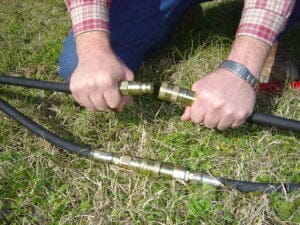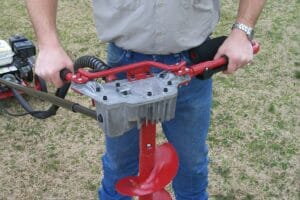Store Your Earth Drill Properly this Winter
Most contractors and rental centers that employ earth drills will experience an approximately 3-4 month winter period in which the equipment is not being used. Before storing your Little Beaver earth drill for the season, take some time to thoroughly examine the drill and ensure that all components are in working order. The simple steps below will ensure your machine is ready to go in the spring.
Hydraulic Hibernation
 To prepare a hydraulic model for storage, remove the shroud between the tank and the engine to inspect the coupling component. Make sure the rubber spider is not worn or missing pieces. Check for hose leaks or loose connections and look for any cuts or cracks that might be causing them. Additionally, lock the drive head into the “storage” position by pivoting the handle.
To prepare a hydraulic model for storage, remove the shroud between the tank and the engine to inspect the coupling component. Make sure the rubber spider is not worn or missing pieces. Check for hose leaks or loose connections and look for any cuts or cracks that might be causing them. Additionally, lock the drive head into the “storage” position by pivoting the handle.
Don’t leave your machine out in the cold all winter. Hydraulic oil thickens as it becomes cold, which could damage the hydraulic system and the hoses. The hydraulic oil needs to be changed every three months or 100 hours of use, so it’s more efficient to simply drain the oil for the storage period; just don’t forget to replenish it in the spring. You should use premium mineral oil with anti-wear and anti-foaming additives. If you are using the drill in frigid temperatures, we recommend ISO VG 32-grade oil (46 for normal temperature operation and 68 in warmer climates).
Year-End Mechanical Maintenance
 Routine maintenance during active drilling periods of the year keeps your machine primed for the most rugged applications. This includes inspecting, cleaning and lubricating applicable parts for every 30-40 hours of use. But when your drill’s hard work is done and it’s time for its seasonal slumber, ticking off some end-of-the-year checkboxes will make sure it’s ready to go next spring.
Routine maintenance during active drilling periods of the year keeps your machine primed for the most rugged applications. This includes inspecting, cleaning and lubricating applicable parts for every 30-40 hours of use. But when your drill’s hard work is done and it’s time for its seasonal slumber, ticking off some end-of-the-year checkboxes will make sure it’s ready to go next spring.
Store the drill so that the flexible shaft is stretched straight and not curled up; check for cracks or wires on the outer housing. Look for rust on the push button connector and if you find any, wipe it down with WD-40. Check out the throttle cable as there’s a good chance you’ll need to take things apart to clean it. If frayed, it should be replaced.
Ready for Spring
Some storage preparation steps apply to both hydraulic and mechanical units. There are a couple of options for winterizing the gasoline-powered fuel system of your mechanical or hydraulic drill. The simplest is to completely drain the gas tank. You can also add fuel stabilizer solution, which forms a protective layer by bonding with gasoline to prevent evaporation. It also stops the buildup of sticky resins that can destroy a carburetor and remains effective for up to one year.
Fuel stabilizer is recommended any time a gas engine, especially an older one, will be out of use for three weeks or more. Fill up the rest of the tank upon taking it out of storage, as this will diffuse the stabilizer. Nonethanol gasoline is best for this type of equipment, especially when putting it away for storage or filling up in the spring. Ethanol’s corrosive effects increase the longer the machine sits idle, and the blend doesn’t always mix well with stabilizer. Once this is done, grab a couple wrenches and tighten up all bolts, as they can become loose through the course of routine drilling and transportation.
Always store earth drills in a warm, dry space. Left to the elements in a high-moisture area, the steel will eventually develop rust. Make sure to keep them in a space that doesn’t get heavy foot traffic so it won’t get knocked over or otherwise disturbed, especially if there is a chance of animals or small children being nearby.
Don’t leave the blades dull or rounded since drilling with them can damage the flighting of your auger. Install new blades if they are replaceable or sharpen your carbide blades. Sharpen with a carbide bench grinding wheel tilted to a 5-7 degree relief angle. Clean your blades with warm, soapy water. Do not use a pressure washer, which is too abrasive and can cause damage.
Your Little Beaver Needs a Little Love
Properly storing your earth drilling equipment will keep it running smoothly for many years to come. For any maintenance questions, reference your owner’s manual, check out our online service videos or contact us for direct consultation.